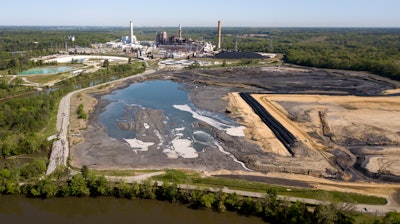
WASHINGTON (AP) — The Environmental Protection Agency is taking its first major action to address toxic wastewater from coal-burning power plants, ordering utilities to stop dumping waste into unlined storage ponds and speed up plans to close leaking or otherwise dangerous coal ash sites.
Plants in four states will have to close the coal ash ponds months or years ahead of schedule, the EPA said Tuesday, citing deficiencies with groundwater monitoring, cleanup or other problems.
Coal ash, the substance that remains when coal is burned to generate electricity, contains a toxic mix of mercury, cadmium, arsenic and other heavy metals. It can pollute waterways, poison wildlife and cause respiratory illness among those living near massive ponds where the waste is stored.
The actions mark the first time the EPA has enforced a 2015 rule aimed at reducing groundwater pollution from coal-fired power plants that has contaminated streams, lakes and underground aquifers.
U.S. coal plants produce about 100 million tons (90 million metric tons) annually of ash and other waste.
The Obama administration regulated the storage and disposal of toxic coal ash for the first time, including a requirement to close coal-ash dumping ponds that were unstable or contaminated groundwater. The Trump administration weakened the Obama-era rule in 2020, allowing utilities to use cheaper technologies and take longer to comply with pollution reduction guidelines that are less stringent than what the agency originally adopted.
EPA Administrator Michael Regan said the actions announced Tuesday will ensure that coal ash ponds meet strong environmental and safety standards and that operators of industrial facilities are held accountable.
“I’ve seen firsthand how coal ash contamination can hurt people and communities,'' said Regan, a former North Carolina environmental regulator who negotiated with Duke Energy what state officials say was the largest cleanup agreement for toxic coal ash.
“For too long, communities already disproportionately impacted by high levels of pollution have been burdened by improper coal ash disposal,'' Regan said. “Today’s actions will help us protect communities and hold facilities accountable. We look forward to working with our state partners to reverse damage that has already occurred.''
In separate letters sent Tuesday, EPA denied requests for extensions of coal ash permits by the Clifty Creek power plant in Madison, Indiana; James M. Gavin plant in Cheshire, Ohio; and the Ottumwa plant in Ottumwa, Iowa.
The Greenidge Generation plant in Dresden, New York, was ruled ineligible for an extension. The former coal plant now uses natural gas.
The H.L. Spurlock plant in Maysville, Kentucky, will be required to fix groundwater monitoring as a condition for continued operation of its coal ash pond, the EPA said.
Lisa Evans, a senior attorney for the environmental group Earthjustice, said the enforcement action "sends a strong message to industry that (compliance with the EPA rule) is not a paperwork exercise. It requires them to clean up these toxic sites.''
Frank Holleman, a lawyer for the Southern Environmental Law Center who has battled Duke Energy and utilities over coal ash disposal, said the enforcement action offers significant protections for clean water nationwide.
"The EPA has sent a clear message that (power plant operators) cannot leave coal ash sitting in primitive, polluting ponds across the country,'' he said.
Utilities in Alabama, Georgia, Tennessee and other states that are still storing coal ash in leaking, unlined pits sitting in groundwater and next to waterways are among those affected by the decision, Holleman said.
Michelle Bloodworth, president and CEO of America's Power, a trade association that represents coal-fired utilities, said the group was reviewing the EPA's announcement. “On its face it doesn’t make sense to shut down prematurely coal plants that provide the security of on-site fuel storage or serve as an alternative when prices of natural gas and other sources spike" or are not available, she said.
In a related action, EPA sent letters to operators of four current or closed coal-fired power plants, saying they need to make improvements to coal-ash sites to comply with EPA rules. The AES power plant in Puerto Rico and three closed plants — the former Beckjord power station in Ohio, Tecumseh Energy in Kansas and Gallagher Generating Station in Indiana — all received EPA warning letters.
Coal ash storage and disposal goes back decades, but went largely unregulated until a 2008 spill at a Tennessee Valley Authority power plant in Kingston, Tennessee. A containment dike burst and flooding covered more than 300 acres (121 hectares), dumped waste into two nearby rivers, destroyed homes and brought national attention to the issue.
In 2014, an estimated 39,000 tons of coal ash spewed into the Dan River after a drainage pipe running below a waste dump collapsed at a Duke Energy plant in Eden, North Carolina. The toxic sludge turned the river gray for more than 70 miles (112 kilometers).
The EPA on Tuesday reiterated its "consistently held position that surface impoundments or landfills cannot be closed with coal ash in contact with groundwater.'' Limiting contact between coal ash and groundwater after closure is critical to minimizing contaminants released into the environment and will help ensure communities near the sites have access to safe water for drinking and recreation, the EPA said.






















